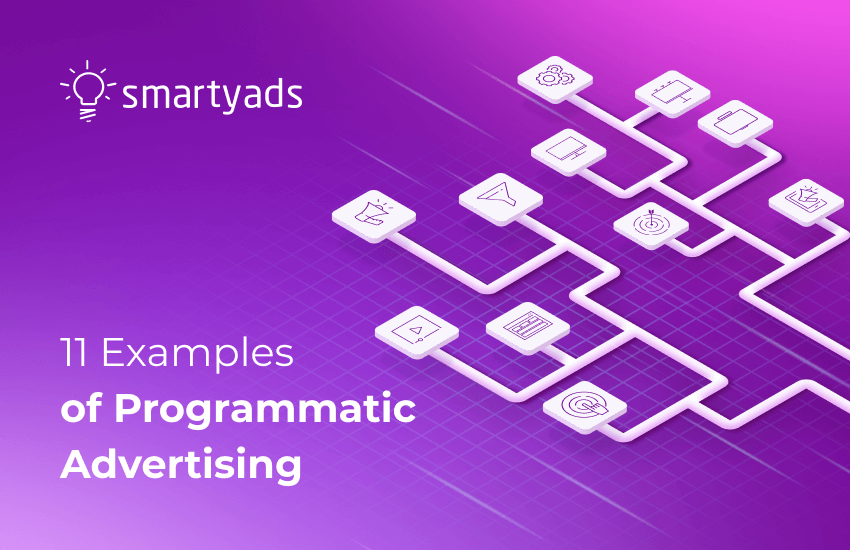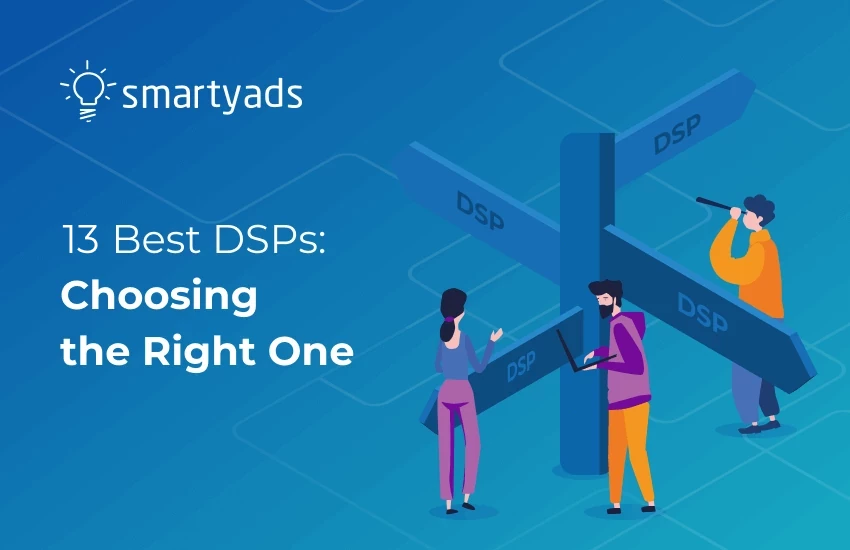Programmatic advertising spending will hit the bar of $725 billion by 2026, highlighting its significance in digital marketing.
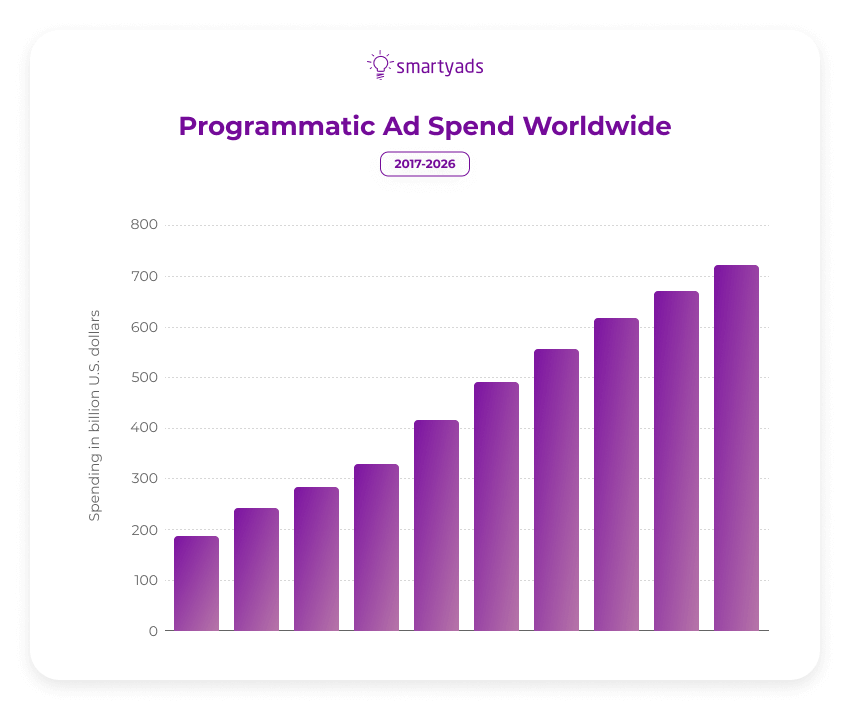
Programmatic ads may come in many forms, including display, video, audio, native, connected TV (CTV) ads, digital out-of-home (DOOH), etc.
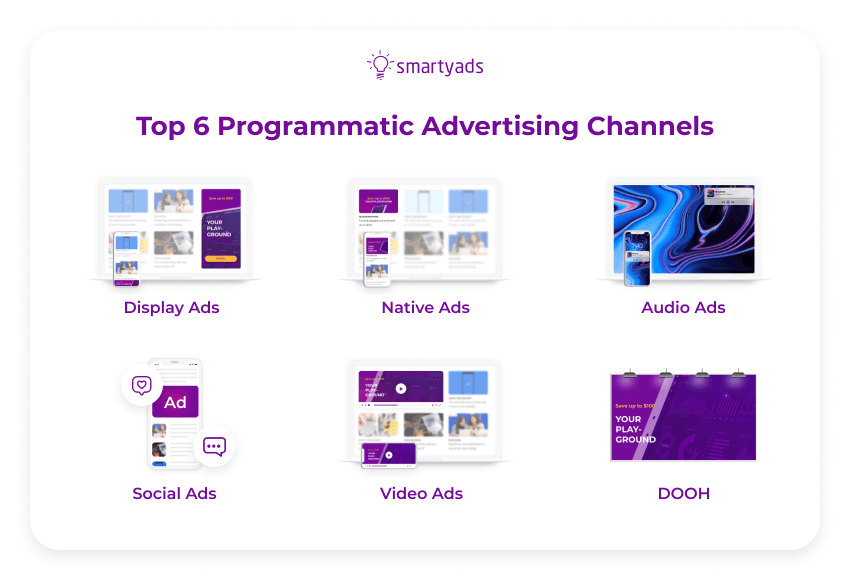
What is programmatic advertising?
Programmatic advertising automates the process of buying and selling online ads through a large number of websites, using artificial intelligence and machine learning algorithms.
It provides customers with personally-tailored and relevant experiences based on the data they interact with.
Benefits of programmatic ads
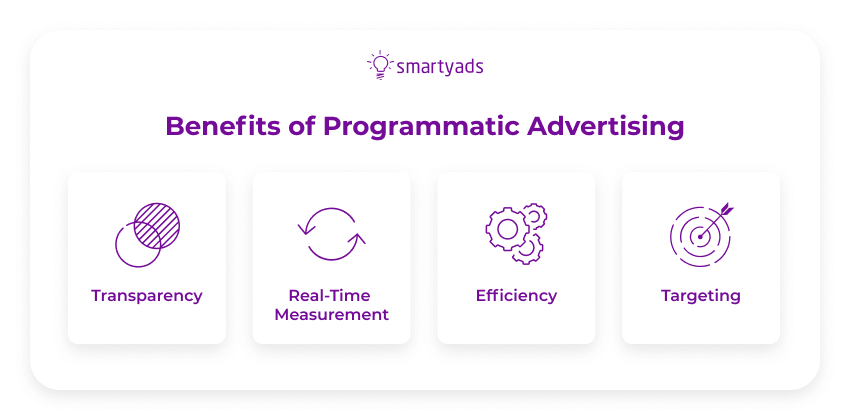
One of the greatest advantages of a programmatic ad is that it enables advertisers to make data-driven decisions and boost ad revenue.
Moreover, it is transparent, provides a close look at KPIs, and helps target particular audiences.
Let's take a look at the key benefits of using programmatic advertising.
Transparency
Programmatic advertising provides advertisers with transparency that offers them complete visibility over their campaigns.
They can see precisely what websites their ads are being displayed on, what types of audiences are viewing them, and the return on their investment.
Real-Time Measurement
Programmatic advertising gives round-the-clock access to key metrics. They include CTR, total views, conversions, impressions, media cost, etc.
You will only spend money on what you know will be effective because you can see results in real time.
Efficiency
Automating the process of buying ad space removes human error and boosts efficiency.
Campaigns can be optimized across machine learning applications to boost ROI and drive success.
Audience Targeting
Your most valuable audience members will be found for you, so you'll hit your target audience every time. You can also choose the best devices to advertise on.
Programmatic Advertising Examples
How John Lewis Achieved a 346% Higher ROI on Black Friday
John Lewis is a well-known department store in the United Kingdom that offers premium quality merchandise.
The company had a difficult situation and wanted to boost revenue.
The business decided to cooperate with a DSP and purchase programmatic ad inventory during the Black Friday weekend leading up to key days.
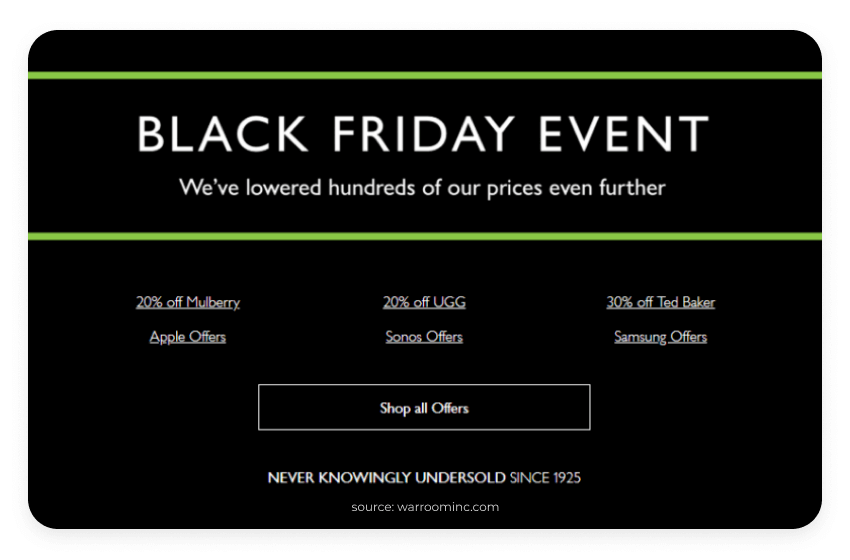
To reduce inventory and bidding costs, the business arranged private marketplace agreements with premium sites ahead of key days.
Additionally, their DSP created an innovative approach called 'programmatic guaranteed', which enabled the company to secure significant cut-through for millions of advertisements during Black Friday.
By partnering with a trustworthy DSP, the business was able to reach high-value customers at the right time. This resulted in a 346% ROI, which was higher than their initial goal!
Key takeaways:
- On major events days, innovative programmatic advertising strategies can boost ROI;
- Reduce inflated marketplace costs with programmatic ads direct and private deals;
- You can optimize private deals for highly optimized ad results with programmatic ads.
How Lacoste Generated 19,749,380 Impressions and 2,290 Sales with Programmatic Display Ads
Lacoste is a famous French designer brand with a green crocodile logo.
Lacoste wanted to increase sales in France, the United Kingdom, and Germany during the summer sale period.
The business implemented a programmatic marketing campaign that utilized display advertising to personalize content and drive sales.
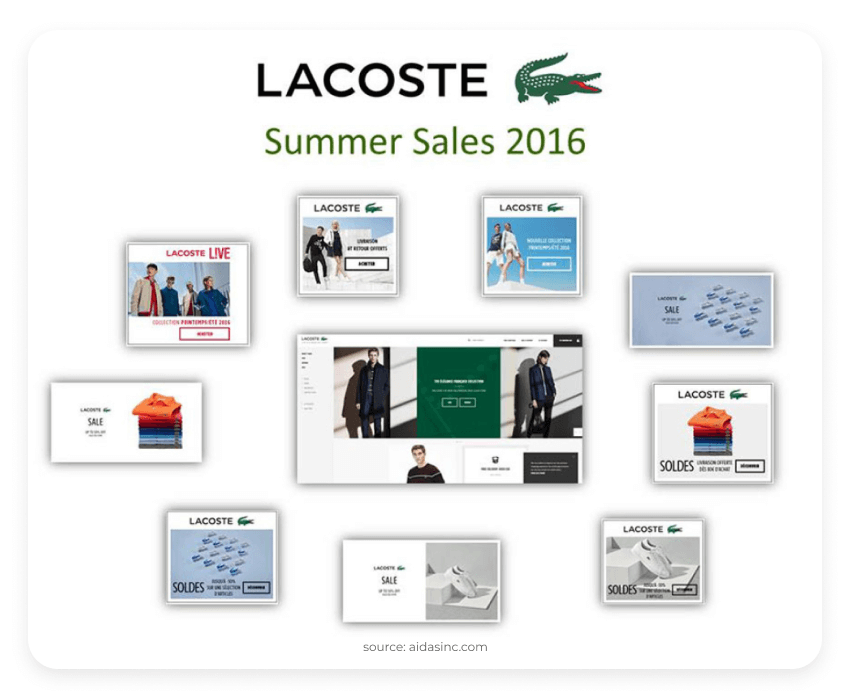
Here are some steps of this programmatic advertising example:
- By leveraging available customer data, Lacoste team created customer profiles through in-depth audience analysis.
It enabled Lacoste team to segment customers and utilize various programmatic advertising methods to target and retarget customers.
- They invested considerable resources to test their creative media, fine-tuning and re-running their ads to maximize performance.
Everything was evaluated, including the creative media, marketing channel, daily ad spend, and banner format.
Additionally, they effectively improved their ad campaign by split-testing results.
To sum it up, Lacoste generated 19,749,380 impressions and 2,290 sales throughout their key target markets.
Key takeaways:
- Focusing on the fundamentals can significantly boost sales, reach the audience and optimize ad spend;
- A/B testing and creative development are essential to programmatic advertising;
- An ad campaign is only as effective as its real-time adjustments.
How Audi Boosted Conversion Rate by 400%

Audi's programmatic ad campaign is one of the most well-known programmatic advertising examples in the automotive industry.
The Audi Q2 is a fully-customizable luxury crossover SUV, so it's not surprising that the car manufacturer strives for a remarkable launch.
To prepare for the launch of its customizable vehicle, the company aimed to further personalize its programmatic marketing efforts and create a campaign that lived up to its famous slogan, "Vorsprung durch Technik" (Advancement through Technology).
In close collaboration with Google and utilizing Display and Video 360, Audi adopted a data-driven strategy that optimized its most valuable target audience by combining all consumer data.
On the Audi website, data included floodlight tags, allowing the creation of retargeting lists of previous users and in-market segments. This enabled Audi to identify new users whose online behaviors showed their intention to buy a car.
A car configurator on Audi's website allowed customers to digitally personalize their ideal vehicle, enabling Audi to collect data about users' style preferences. These valuable insights were utilized to fuel the creation of dynamic ad creatives, ensuring a compelling and tailored advertising experience.
By considering a customer's position in the sales funnel and their unique style preferences, Audi ensured that the ad served to each individual was consistently relevant, personalized, and visually captivating. This approach guaranteed that every customer received tailored advertisements that specifically catered to their needs and preferences, enhancing their overall engagement and experience.
Buying ads programmatically resulted in an impressive average conversion rate that was four times higher compared to traditional ad buying methods, while creative ads were twice as effective as standard ads.
How Unilever's Axe Romeo Relaunch Tells a Story 100,000 Various Ways
Unilever is the company that created Axe Body Spray.
With programmatic advertising, Unilever sought to test the limits of personalized content.
As a result, they created an ad campaign for their white label line in Brazil, using the story of Romeo and Juliet with a twist.
Here are some steps about this programmatic advertising example:
- They created 100,000 unique 1-minute trailers that were based on their customers' preferences;
- Every customer would receive a personalized video based on their data and profile;
- Unilever implemented programmatic ads to improve delivery.
As a result, the content was created to resonate with the relevant people. If the user was identified as having one of those characteristics, the video storytelling engine would personalize it in real time.
To sum it up, 43,000 unique videos were produced every day. The ad campaign exceeded client and agency benchmarks by 10-20%.
Key takeaways:
- Personalized storytelling helps your brand create an impression;
- Creative programmatic advertising media is a powerful way of piercing through the noise.
How IHG Hotels Disrupted the Metasearch Industry Using Programmatic Ads
The Intercontinental Hotels Group (IHG) is a global brand that owns well-known hotels such as The Holiday Inn and Regent Hotels.
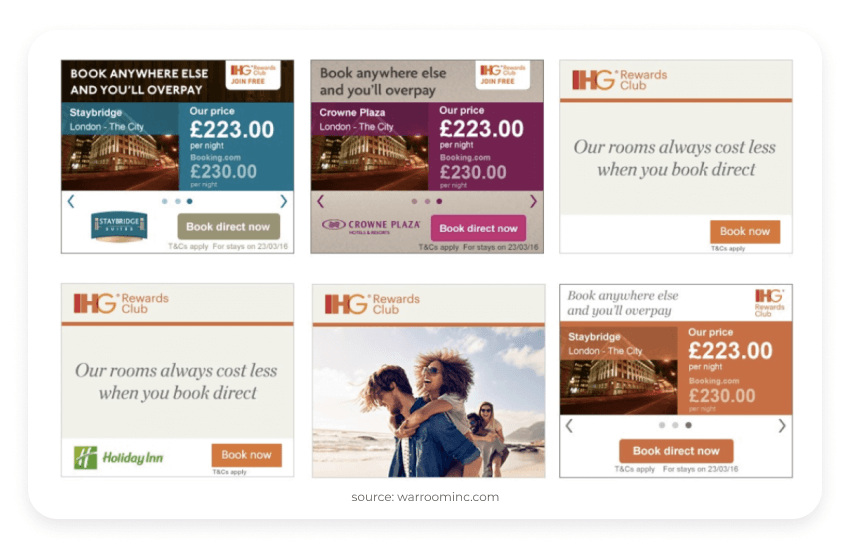
After analyzing the data on how people book hotels, it turned out that 20% of people shift away from direct bookings to metasearch websites. People wanted the lowest prices, and comparison websites satisfied their requests. The request was based on a lie.
So the business created a programmatic advertising campaign to dispel this myth. Best of all, they might target individuals already searching for particular hotel prices.
By providing a 'book direct option', much traffic was returned to the hotel's websites.
COO Matt Luscombe added the lowest price guarantee to ensure customers knew they wouldn't find a better price on another website. Combined with sophisticated targeting, the programmatic creative campaign was wildly successful.
The Intercontinental Hotels Group is eager for other travel brands to use these strategies so that the industry concentrates on enhancing the guest experience.
Key takeaways:
- Programmatic advertising has the potential to disrupt your industry;
- With creativity, it has the potential to educate and convert targeted customer segments effectively.
How The Economist Got 3.6 Million People to Take Action
The Economist, the business magazine, was looking to reach different target audience segments with ads on topics they would be interested in.
You can see these ads below:
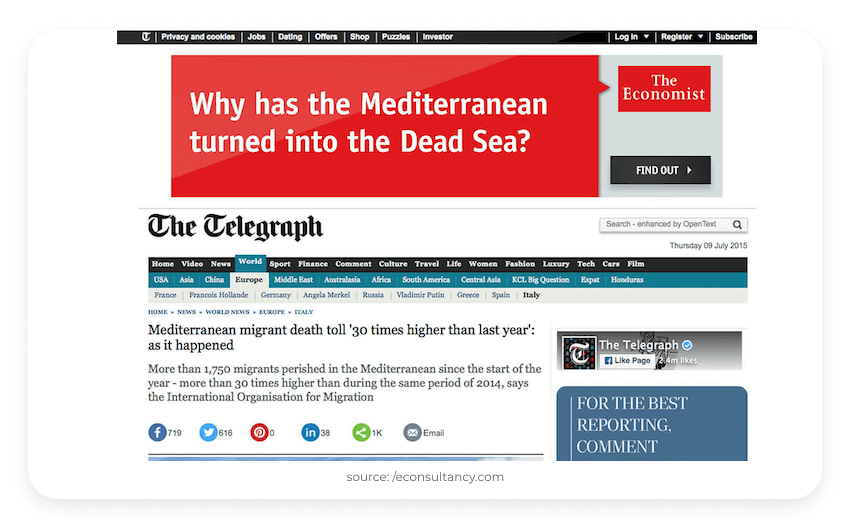

Here are some steps of this programmatic advertising example:
- The Economist used programmatic digital display ads to a diverse target audience of 650,000 individuals;
- The main goal was reaching the right customers in the right places with the relevant content. As a result, ads were set directly next to articles on similar topics that their target audience was already reading.
To sum it up, The Economist utilized £1.2 million to accomplish 650,000 potential customers, and the ad campaign ROI was 10:1.
Key takeaways of this programmatic advertising example:
- Programmatic ads give brands a way to reach lost audience segments;
- Evaluate your content to identify what resonates best with your audience;
- Engage with your target audience on platforms where they already gather.

Google implemented programmatic marketing in 2014, focusing on the Google Search App to boost ad campaign effectiveness.
Google utilized first- and third-party data to reach the relevant audience and optimized its ad campaigns in real time, recycling data to enhance its ad campaign strategy.
The Google Search App campaign had a huge success, including:
- 30% more customers reached three times more often;
- 30% lower CPM compared to the previous year;
- 50% boost in brand recognition.
Kellogg's
Kellogg's utilized programmatic advertising to improve brand message viewability and frequency in order to boost offline sales. These hyper-targeted ads worked to inspire audiences and drive results.
Due to these programmatic advertising campaigns, Kellogg's was able to accomplish the following:
- 2x to 3x more precise audience targeting;
- 70% boost in viewability rates.
How Amanda Foundation Utilized Targeted Ads for Adoption of Homeless Animals
The Amanda Foundation, a non-profit organization, has partnered with the agency in an effort to boost adoption rates for animals in shelters.

This non-profit organization struggled to find homes for rescued animals, so a programmatic ad campaign was exceedingly useful.
With the Digital Pawprint creative ad campaign, the agency has developed personalized banner ads that resonate with customers based on their online behavior.
This programmatic ad campaign included real images of adoptable animals and cleverly paired them with specific breeds, hobbies, and personality traits to encourage users to click on the ads.
By leveraging data and advanced targeting techniques, the Amanda Foundation was able to reach the right audience, resulting in increased adoptions for the shelter.
This innovative use of programmatic media and creative technology is an effective way to match pets with their ideal owners.
Key takeaways of this programmatic advertising example:
- Programmatic advertising media provides brands with the ability to identify and engage with their ideal audience;
- By targeting specific segments with customized media, brands can significantly increase their chances of converting prospects into customers;
- Incorporating creative and engaging advertisements can further enhance ad campaign conversions, helping brands achieve their marketing objectives more successfully.
How Topman Tailored Creatives for Different Audiences
Topman, a men's fashion retailer, advertised its new khaki collection with programmatic ads.
These ads targeted various segments of the retailer's market with their images, resulting in a successful programmatic ad campaign.
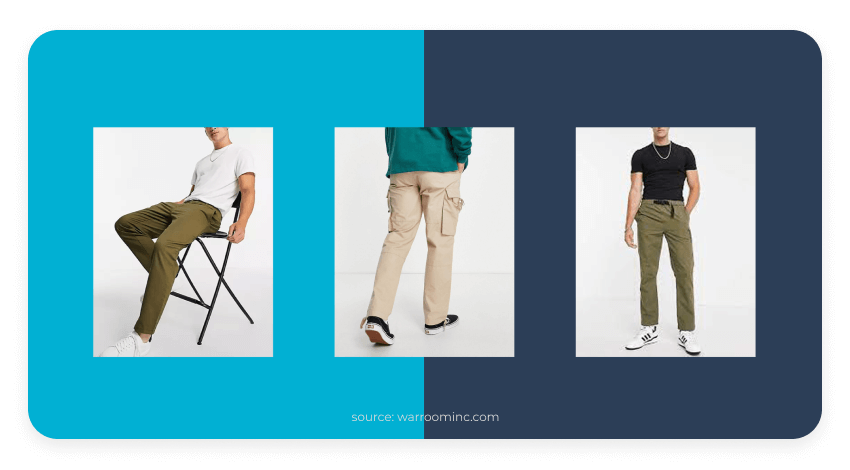
For instance, the brand took photos of a stylish casual look and an outfit that one could see on New York City streets during a fashion week.
These photos were used as advertising creatives, allowing the retailer to reach every customer within its target audience.
Following this programmatic advertising example, you should consider your various ad creatives and how they can attract different types of prospective customers.
Turner Sports boosts ad recall
Using programmatic ads, Turner Sports aimed to support the National Basketball Association Season Tip-Off for 2016 events.
The company utilized data from previous Google Ads campaigns to identify a target audience. Then, the business leveraged Google Marketing Platform to analyze the audience data and identify the most valuable audience segments for retargeting.
To accomplish its goal with Google Marketing Platform, Turner Sports implemented a programmatic video advertising campaign that hit 6 million unique viewers in the United States. These advertisements included real-time videos of fans and athletes from tip-off events nationwide.
Programmatic advertising has supported the business in attracting audiences, increasing brand awareness, and growing the community of sports fans.
As a result of this campaign, Turner Sports achieved a 17% growth in ad recall and a 7% growth in brand recognition for "NBA on TNT".
How to run effective programmatic ad campaigns
Stay up to date with the latest programmatic ad changes
It is essential to stay informed about the current developments in this sphere. You need tech-savvy individuals who can effectively communicate with your target audience.
Put customer insight at the wheel
Brands require survey data that reflects real people in order to identify the customer touchpoints that matter and understand the priorities of their target audience.
Include your first-party data
First-party data isn't canceled out by survey data. Existing customer behavior information is an important part of the research pie. However, it is only contextualized, and the complete picture is revealed when customer motivations and attitudes are added.
Optimize
You can modify your advertising message, placement, and frequency using programmatic advertising. Additionally, you must combine real-time analytics with what people say and continue evaluating.
Measuring the effectiveness of campaign data
Track the effectiveness of your campaign from beginning to end using the same combination of analytics and survey data. And if you desire, you can investigate further with custom studies that evaluate your impact on actual individuals.
Conclusion
We hope our compilation of programmatic advertising examples provides you and your team with a wealth of inspiring ideas and practical insights into the vast potential of programmatic advertising and how it's being used in the real world.
From targeting specific individuals to breaking through the clutter of online ads and boosting sales. With its data-driven and automated approach, programmatic advertising enables brands to achieve new levels of marketing effectiveness.
Programmatic advertising plays a crucial role in the organization of advertising processes today.
Our experts strive to create an efficient and transparent programmatic ecosystem, taking into account the latest developments in ML and AI.
If you want to get the highest ROI, Launch impactful ad campaigns on SmartyAds DSP!
